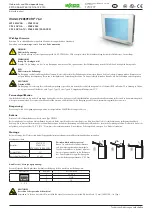
If required this procedure will automatically correct
the compass offset value accessible from the Vessel
Settings menu.
Note:
If the alignment fails it means that the pilot
sensor is more than a 10° deviation between your
COG heading and the pilot sensor, in this situation
the pilot sensor position must be checked.
11.11 Commissioning
You can commission an Evolution autopilot using
the Pilot settings menu on your multifunction display.
All set-up and commissioning procedures must be
carried out before using the autopilot.
Commissioning the autopilot system consists of the
following procedures:
• Vessel Hull Type selection.
• Drive Type selection.
• Rudder check
• Motor check
Commissioning pre-requisites
Before commissioning your system for the first time,
check that the following processes have been carried
out correctly:
• Autopilot system installation completed in
accordance with the Installation instructions.
• SeaTalk
ng
network installed in accordance with the
SeaTalk
ng
Reference Manual.
• Where fitted, the GPS receiver has been installed
and connected in accordance with the associated
Installation instructions.
Check also that the commissioning engineer is
familiar with the installation and components of the
autopilot system including:
• Vessel type.
• Vessel steering system information.
• What the autopilot will be used for.
• System layout: components and connections (you
should have a schematic of the vessel’s autopilot
system).
Vessel hull type selection
The vessel hull type options are designed to provide
optimum steering performance for typical vessels.
It is important to complete the vessel hull type
selection as part of the initial set-up, as it forms a
key part of the commissioning process. You can
also access the options at any time with the pilot in
Standby from the Pilot Set-up page by selecting:
Pilot Settings > Vessel Settings > Vessel Hull
Type
.
As a general guide, select the option that most
closely matches your vessel type and steering
characteristics. The options are:
•
Sail
.
•
Sail (slow turn)
.
•
Sail Catamaran
.
•
Power
•
Power (slow turn)
.
•
Power (fast turn)
.
It is important to be aware that steering forces (and
therefore rate-of-turn) vary significantly depending
on the combination of vessel type, steering system,
and drive type. Therefore, the available vessel hull
160
gS Series
Содержание Raymarine gS 195
Страница 2: ......
Страница 26: ...26 gS Series...
Страница 43: ...D 36 mm 1 4 in E 39 2 mm 1 5 in F 90 mm 3 5 in Planning the installation 43...
Страница 44: ...44 gS Series...
Страница 110: ...110 gS Series...
Страница 146: ...146 gS Series...
Страница 174: ...174 gS Series...
Страница 175: ...Chapter 13 Man Overboard MOB Chapter contents 13 1 Man overboard on page 176 Man Overboard MOB 175...
Страница 178: ...178 gS Series...
Страница 181: ...Chapter 15 Fuel manager Chapter contents 15 1 Fuel manager overview on page 182 Fuel manager 181...
Страница 196: ...196 gS Series...
Страница 218: ...218 gS Series...
Страница 328: ...328 gS Series...
Страница 362: ...362 gS Series...
Страница 411: ...Chapter 31 Technical specification Chapter contents 31 1 Technical specification on page 412 Technical specification 411...
Страница 418: ...418 gS Series...
Страница 438: ...438 gS Series...
Страница 439: ......
Страница 440: ...www raymarine com...
















































